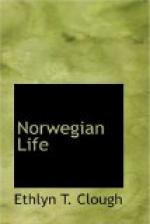In 1332, King Magnus took charge of the government. He was a ruler of benign and good disposition toward the common people, whose interests he always furthered. But he lacked strength of character, and was not able to control the obnoxious nobles. The provinces of Scania and Bleking suffered greatly under Danish rule, which was changed into German oppression when handed over to the counts of Holstein as security for a loan. The people of Scania rose in revolt and asked for protection from King Magnus. At a meeting in Kalmar, in 1832, both provinces were united to Sweden. But the king had to pay heavy amounts in settlement, which were increased when Halland was procured in a similar way.
King Magnus was, at his zenith of power, one of the mightiest monarchs in Europe, having under his rule the entire Scandinavian peninsula and Finland, a realm stretching from the sound at Elsinore to the Polar Sea, from the river Neva to Iceland and Greenland. In 1335, King Magnus decreed that no Christian within his realm should remain a thrall, thus practically abolishing the remnants of slavery.
But financial difficulties arose, an unsuccessful crusade was attempted, the “Black Death” came from England to Norway in 1350 and spread with great rapidity, and several other things convened to fill the people with discontent, so that the union with Norway did not prove a happy one. A separation was brought about in 1844, when Haakon, the younger son of Magnus, was made king of Norway, Magnus remaining in power until Haakon came of age, and his older son, Eric, was chosen king or heir-apparent of Sweden. It seems that this division had been preconceived by King Magnus when he gave this older son the Swedish name of Eric and to the younger the Norwegian name of Haakon, both equally characteristic of the royal lines of the respective countries.
It was during the Folkung period that there flourished one of the most remarkable and renowned of Swedish women, St. Birgitta. At the Swedish court, she was the highest functionary of Queen Blanche, where she gathered deep and strong indignation against the mighty and powerful world. By some she is considered a reformer before Luther, because she insisted on direct communication between the communicant and God without the mediation of priests or saints. Yet there was a difference between Birgitta and Luther, because the latter sought to reform institutions, while the former would reform the upholders of the institutions.
After the reign of Magnus and his sons, there came for a brief season Albrecht of Germany, and after him Queen Margaret, who united for the first time in history the three Scandinavian countries and their dependencies. This period was denominated one of unionism against patriotism, and closed with the rebellion of Denmark and the ascending of the Swedish throne by Christian of Denmark, who claimed the right of his descent from St. Eric. Then followed the public execution under edict of King Christian, when eighty-two persons were beheaded, including many bishops and men of note in Sweden.




